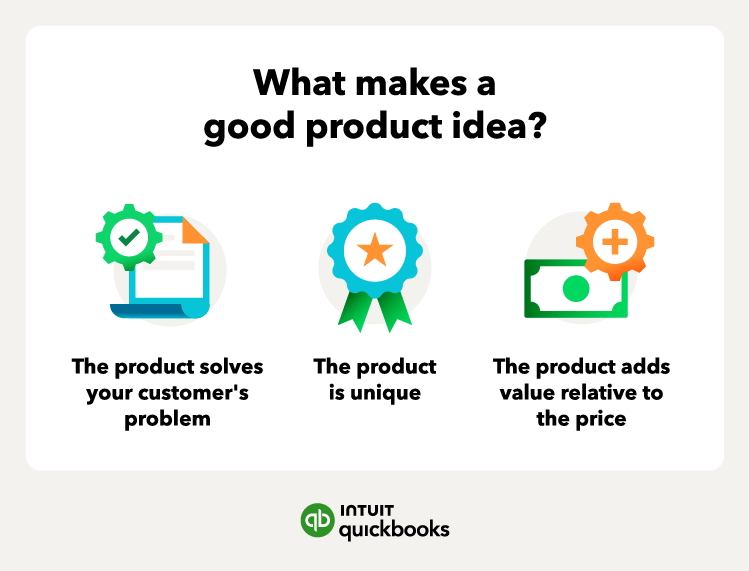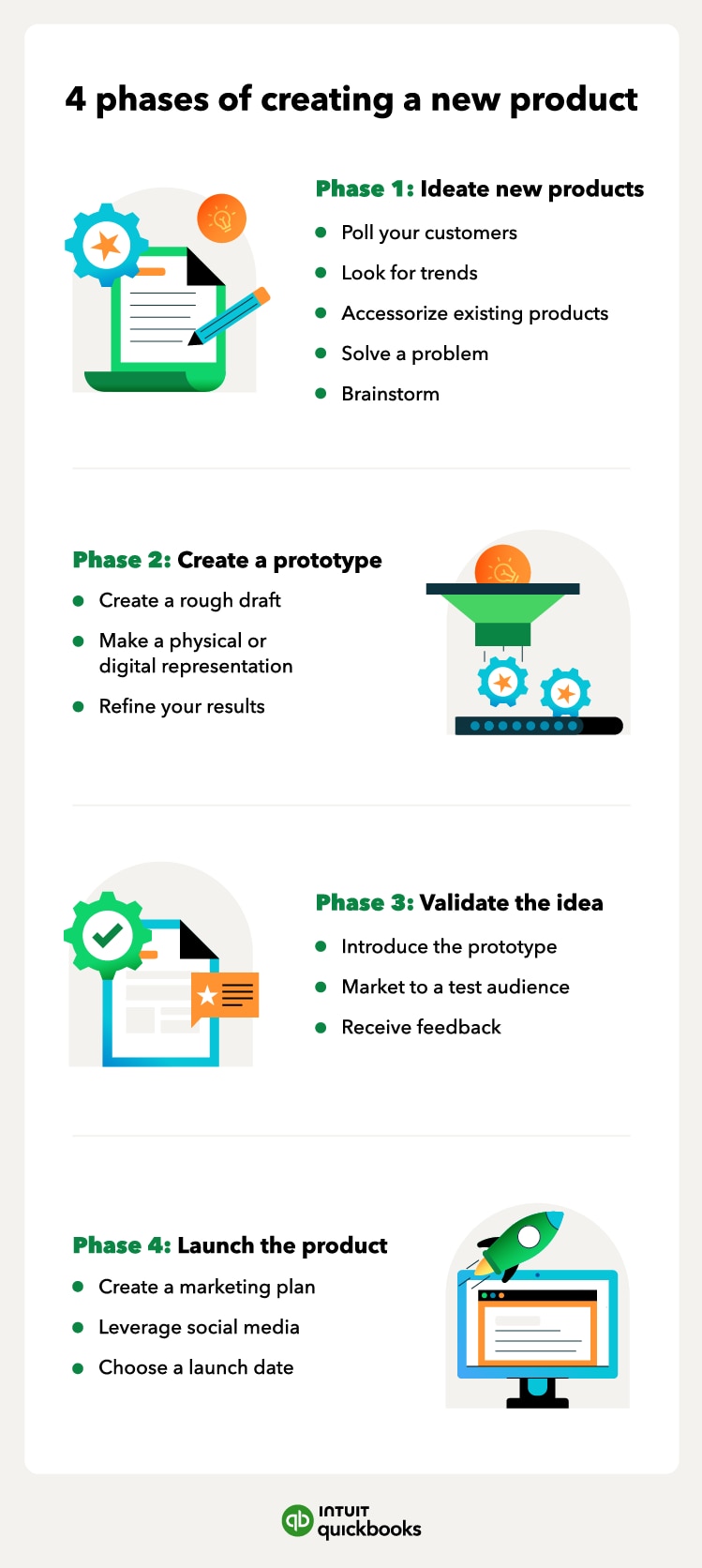In the small business and entrepreneur world, it’s essential to focus on business growth. As time passes, you will likely want to diversify your product offering to better compete in the market. The same holds true for your existing customers. The product that brought them on board may not be the best product to keep them coming back time and time again. What you’re going to need is an influx of new product ideas. We’ll cover the elements of a good product, how to create it, and how to validate it with your target audience.

A practical guide to gathering new product ideas
3 key elements of a good product

As you’ve probably already noticed, good product ideas rarely just fall into your lap. Take it from retail giants like Amazon, Etsy, or eBay—not only are they dominating in their markets, but they’re constantly changing and adding new products and features to keep them relevant.
If it was that easy, everyone would be a successful business owner. It takes time, creativity, and often a hard work to create a great product. Good products typically have one or more of the following elements:
- The product solves your customer's problem
- The product adds value relative to the price
- The product is unique
15 new product ideas for inspiration
New product ideas are being released each year to meet the demands of customers. This includes niche products, T-shirts, skincare, and gyms—all vying for bigger profit margins.
Many people want the next best thing, and this holds true regardless of your business’s structure or what industry you operate in. This is a great benefit for you as a company because it ensures if you meet demand, demand will always be there to sustain your company and influence growth. Let’s explore some recent innovations and why they are exceptional.
Technology
You’ll be hard-pressed to find another industry that evolves as quickly as technology. Doesn’t it feel like new tech is getting released daily? That's due to customer demands and strong market share competition between competing companies. Here are a few recent ideas that have taken off:
1. Wireless headphones: This product meets the needs of wireless convenience by allowing customers to listen to music, stream podcasts, or make phone calls anytime, any place. While AirPods continue to be the market leader, new models continue to emerge from competitors—often at lower price points.
2. Virtual reality: VR provides additional depth to social media, e-commerce businesses, and digital products. Products like Oculus continue to produce new versions, games, and experiences inside the virtual realm.
3. Smart homes: Smart tech allows for a hands-free experience and convenience at home. Devices like Alexa home can now work with devices such as light switches, bulbs, speakers, and televisions to operate on voice command or from your smart device.
4. Electric vehicles: These cars offer sustainable transportation that's better for the environment. Tesla has set the stage for EVs around the globe and now predecessors are clamoring to get in on the action, with new electric vehicles being introduced each year by different manufacturers.
5. Health technology: You can now track and monitor your intimate health data through smaller devices like smartwatches. For example, the Apple Watch can now track your oxygen level, heart rate, and sleep patterns all from your wrist and translate that data into usable insights on your smart device.
Construction
Construction has long been deemed slow-moving when it comes to change and advancement. Many companies are still learning to adapt to digitizing paperwork and prefer the old-school pen and paper route. However, there are some great changes that are coming into play for the construction industry that not only make work safer but more efficient, such as:
6. Robotics: Eliminates the human element which reduces error and improves safety
7. Wearable tech: Improves productivity, safety, and risk aversion
8. Exoskeletons: Implements support when moving heavy objects and bending and lifting on the job
9. Drones: Can be used to make certain procedures much more efficient, such as equipment tracking and topographical mapping
10. Modular construction: Lowers build timelines by allowing construction to be conducted off-site and brought in
Child Development
Another great example of an ever-changing industry is child development. Every parent wants the best for their child and is willing to pay to get it. Companies know this and implement technology, child psychology, and artificial intelligence to improve children's safety, growth, and development. A few of the new advancements include:
11. Smart device applications: Prepares children for careers in technology and gets them started with technological skills
12. Classroom tools: Offers assistance to children with different learning styles
13. Video games: Influences visual-spatial development and improves natural abilities
14. Virtual classrooms: Gives children the tools to learn from anywhere, even if they don’t have access to traditional education
15. Advanced monitors: Helps parents monitor sleep patterns, low oxygen levels, and other dangerous infant disturbances
How to create your new product idea

So you know that you want to create a great new product but are unsure where to start. Fortunately, there are several ways to put your best foot forward. From top to bottom:
- Ideate new products
- Build prototypes
- Validate your product
- Market to your customers
Phase 1: Ideate new products
There can be no creation without ideation, so the first task is to brainstorm great product ideas. Whether you draw inspiration from your morning walk or meditation or you need more tangible influences, here are some ideas.
Poll your existing customers
Your customers have a lot to say about your product including likes, dislikes, improvements, and additions. Why not identify what your customer wants by simply asking them? Send out a poll to your email list, visit online forums, or create a poll on your social media platforms to get product ideas flowing in. Questions to include could be:
- What are your biggest challenges?
- What value do we provide?
- Can you give us any detail about what you would change?
- What other products/services would you like to see us offer?
Look for trends
It’s good to keep your ear to the ground at all times when running your small business because you never know what you may find. For example, keeping abreast of the news, Google trends, and what is selling online in your industry can deliver your next big business idea based on the types of products that pop up on your feed.
Accessorize an existing product
Sometimes the best product idea isn’t about starting fresh but instead capitalizing on an existing product and creating an innovative add-on. Instead of trying to create a new product, try doing some market research and accessorizing an existing product, then cross-sell and upsell to your existing customers.
Solve a problem
Have you noticed an unmet need in the market? Maybe a place where you could fill in the gap or solve a problem? These can prove to be great product ideas. Start by taking note of problems you see in your industry, ask your peers and your customers about their current pain points, and then use that information as a starting point for developing a high-quality new product idea.
Brainstorm
When all else fails, there is always good old-fashioned brainstorming. Start at your most creative hours of the day, whether that be 5 AM or 9 PM. Fire up that coffee pot, put on your favorite background music, and let the ideas flow. Sometimes just letting your mind go blank can be the best way to spark some new ideas. Here are some tips to get the creative juices flowing:
- Mind mapping: This is a visual way to approach creating new ideas. You start with one idea and draw lines to connect sub-ideas to the original idea.
- Design thinking: Prioritize the user's needs first. Observe, empathize, and draw conclusions based on your findings.
- Stepladder: Two people begin the brainstorm, then introduce a third, then a fourth, and so on until the whole group has contributed.
Phase 2: Create a prototype
Once you’ve nailed down a new product idea, or a few of them, move into the prototype phase. The prototype phase is important because it gives your audience something tangible to mull over. Building a sample product should be done in three steps:
- Craft the first draft
- Create a physical prototype
- Refine the results
Step 1: Create a rough draft
Sketch out some designs on a piece of paper or through a digital design. These are also known as mockups—they are a baseline of ideas that feature product dimensions, sizes, colors, and materials. It doesn’t have to be perfect but it lets you flesh out your ideas and gives you something to build from.
Step 2: Make a physical representation
Next, it’s time to create a physical or virtual product to showcase. Deciding between the two really depends on the scale and whether or not you run an online business. For instance, if you’re trying to showcase a home design or a real estate mockup, you probably want to go for a virtual representation, due to the outstanding size. However, for something like a new smart device or hardware—something small to scale—it may benefit you to have a physical representation.
Step 3: Refine your results
It won't be perfect on the first try, or the second, or even the 10th, but you want to keep peeling back those layers until the prototype has shed as many imperfections as possible. The goal is to have a seamless product that functions effectively to its target audience during the validation phase. Two steps business owners can take during this phase include:
- Ask the right questions: Dig deeper through the use of mind mapping or brainstorming to uncover the small details that can set your product apart.
- Know the math: Understand your measurements, scales, and costs associated. Even a small change can throw off your initial projections.
Phase 3: Validate the idea
Validation is the phase where you can prove to yourself, your investors, and your customers that your idea:
- Functions properly for its given purpose
- Solves the problem that you’ve identified
- Offers value and practicality
That being said there are several steps to take in order to validate your product idea:
- Introducing the prototype
- Marketing to a test audience
- Receiving feedback from your audience
Introduce the prototype
First, introduce the prototype to friends, colleagues, and family to identify any holes in your idea or problems that may not have surfaced in the development phase. Take this feedback and implement any changes that need to be made prior to introducing the prototype to a test audience.
Market to a test audience
Create a test audience of existing customers from your social media poll, webinar, subscriber list, or loyalty program. This should be an intimate group of 20–30 people that you pitch your idea to. You can send them product samples in return for their feedback or host an event where you showcase your product. Either way, you want them to be able to see, touch, and experience your product.
Receive feedback
The most important part of the validation phase is the feedback you receive from your test audience. This is crucial because it offers insight into purchase intent based on:
- How valuable your product was perceived to be
- How well it accomplished solving the problem
- How willing the audience is to pay for the product based on the value as it relates to the price point
Phase 4: Launch the new product
It’s been a long road to get here and after you’ve made it past the ideation, creation, and validation phases, you may be wondering what’s next. Now is the time to launch and make a splash with your new product. But you don’t want to just throw your product out into the market and see if it can manage—you want to give it the best chance possible to succeed. This includes:
- Creating a plan for social media
- Assigning roles and responsibilities to your team
- Building a marketing plan
- Choosing the right day to launch
Create a solid marketing plan
It doesn’t matter if you have the most useful and pristine product on the market for your niche—if marketing fails, the product will, too. The right marketing plan includes having:
- The target market in mind and what appeals to them
- The correct value proposition, answering why customers should buy your product
- A call to action that draws customers into the close
- Fresh and engaging materials with coinciding colors, product description, and visuals
Leverage social media
Social media marketing is one of the great advantages to a small business, namely because it’s free targeted advertising. But you need to be preparing your audience long before launch day, which means giving value, posting often, and interacting with your customers. To create a social media plan, you want to know:
- What outlets work best with your audience (video, audio, influencers)
- What CTA encourages the best ROI
- What times and days result in the most views
Once you have your social media plan in place, use your marketing materials to captivate your audience and draw them in for the close.
Choose a launch day
You may be assuming that any day is a “good day,” but in reality, if you launch at the wrong time you could be competing with some big-name competition and get lost in the noise. On the flip side, if you launch too early you may not have enough interest generated beforehand. Here are some tips for choosing the best launch day:
- Research which days bigger companies plan to launch
- Roll out a preview to create anticipation for product launch
- Sync your rollout with the market, like right before major purchasing holidays (Christmas, Black Friday, Presidents Day)
Implementing a new product development process for your business
Tackling the new product development process can be both exciting and demanding, especially for small business owners with plenty of tasks to perform on a daily basis. However, implementing shortcuts like automated bookkeeping and powerful accounting software can free up some time to get those creative juices flowing. If you’re a business owner who wants to appeal to your target audience while also increasing profitability, it’s time to expand your business through new product ideas.













